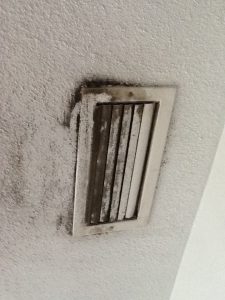
Removing the moisture source is the first step in combatting mold. Photo source: UF/IFAS Extension Pinellas County
Have you seen black, gray, white, or orange stains on your bathroom tile’s grout? Does it look slimy or cottony? Well, you guessed it—that’s mold. There are good molds – yogurts, cheeses, and antibiotics – and bad molds, like the kind that grows in the bathroom.
Mold and mildew refer to a fungus that flourishes in warm, humid, indoor environments. Florida’s heat and humidity supply the ideal habitat for molds of all kinds. Because mold reproduces by releasing spores into the air, mold can go undetected until it has grown into a colony, as in our grout example. Certain molds really are toxic, however, and not only cause health problems, but also damage building structures, furniture, books, and other items.
Health Impacts of Mold
Exposure occurs by touching mold or inhaling air containing its spores. Exposure may cause allergic symptoms and health problems, ranging from sneezing, coughing, or a runny nose to chronic sinus problems, nosebleeds, asthma, skin and/or eye irritation, headaches, difficulty concentrating, and even memory loss.
How to Prevent Mold
Mold is a part of nature and there is no way to keep it entirely at bay. However, we can limit its growth by keeping our house:
Cool – Keep the temperature below 77°F inside your home if you think mold might be an issue.
Dry – Keep the relative humidity below 60%. You can purchase an inexpensive humidity meter (hygrometer) from a hardware store.
- Dry wet surfaces or items as soon as possible. Do not leave anything wet for more than 24 hours.
- Wipe down shower walls with a window squeegee or towel right after showering.
- Fix leaks.
- Pull the shower curtain across the tub/stall to allow the curtain to dry.
- Run the bathroom exhaust fan while you are showering and up to 15 minutes after you finish or open the bathroom window to allow moisture to escape.
- If bath towels remain damp in your bathroom several hours after bathing, hang them in the garage or outside to dry. This reduces moisture in the bathroom and keeps towels from souring.
Clean – Keep your house clean to minimize nutrients for mold.
- Wipe countertops to remove any food residue.
- Refrigerate perishables. (This also reduces foodborne illness risk).
- Clean bathrooms – pay special attention to the shower/tub area and sink to remove soap scum and dead skin cell residue that some molds feed on.
- Change the air conditioner filter monthly.
Mold Removal
When you find mold inside your home, it means there is a moisture problem – leaky plumbing, a roof leak, or water entering around a window or door. Fix the source of the problem or mold will continue to be a problem. If you cannot find the source, if there has been a lot of water damage, or the moldy area is larger than 10 square feet (about a 3 ft. X 3 ft. square), it is recommended to get professional help.
To clean small areas, scrub the moldy surface with a solution of dishwashing or laundry detergent and water, or a mild solution of bleach and water. Wear waterproof gloves and protective goggles to protect your skin and eyes from direct contact with the mold. Wear an N-95 respirator (available at most hardware stores) to avoid inhaling the mold spores. After cleaning, dry the wet area thoroughly to prevent further mold growth.
For more information on controlling mold and mildew, contact your local UF/IFAS Extension Office.
Resource: Keeping It Clean: Controlling Mildew
Source: “Keeping Your Home Healthy,” Taking Good Care of My Home, UF/IFAS Extension.
- Check Your Coverage While the Sun is Shining - July 3, 2025
- Clean Up with Homemade Cleaners - April 28, 2025
- 5 Ways to Cool Your Power Bill - August 28, 2024
